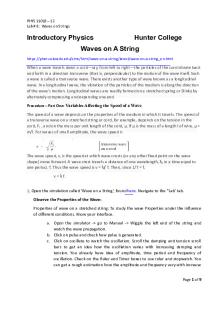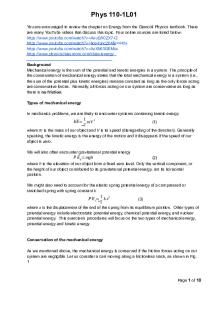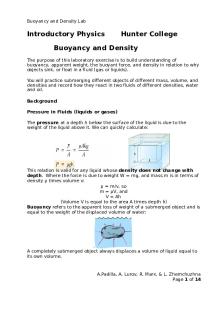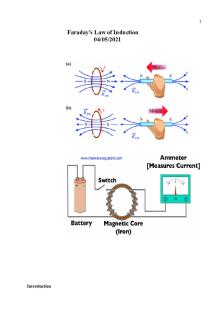Phys lab report 2 PDF

| Title | Phys lab report 2 |
|---|---|
| Author | Hannah Everingham |
| Course | Engineering Physics A: Mechanics, Waves, Electromagnetism and Thermal Physics |
| Institution | University of Canterbury |
| Pages | 14 |
| File Size | 397.5 KB |
| File Type | |
| Total Downloads | 255 |
| Total Views | 580 |
Summary
Name _______________________________ (first) Total Mark (last) ID ______________ Date ____________ Lab Class ________ Physics 101 Semester 1 2017 Formal Report No 2 /30 Understanding the physical limitations of the equation of continuity and Bernoulli’s equation Hannah Everingham 97494884 Partners: ...
Description
Name _______________________________ (first)
Total Mark
(last)
ID ______________ Date ____________ Lab Class ________
Physics 101 Semester 1 2017 Formal Report No 2
/30
Understanding the physical limitations of the equation of continuity and Bernoulli’s equation Hannah Everingham 97494884 Partners: Daniel Bercich Thomas Wilson Daniel Chow
Abstract: This experiment aimed to compare the continuity equation with Bernoulli’s equation in order to understand their physical limitations. It was found that the measurements for water flowing from a hole at the bottom of a beaker were different depending on what equation was used to calculate the velocity. Using the continuity equation, the velocity was equal to 1.23 ms−1 0.024 ms−1 but using Bernoulli’s equation, the velocity at this point was found to be equal to 1.4 ms−1 0.014 ms−1 . In the second half of the experiment, a venturi apparatus was used to measure the velocity of water at different points along the tube. 7 different positions were considered, and once again, using the equation of continuity or Bernoulli’s equation produced different results when finding the velocity of water flowing at the same points. The percentage differences between these two values of the velocity ranged from 72% to 31%, which reinforces strongly the physical limitations of these two equations. Both equations assume that the fluid flowing is laminar, irrotational, incompressible, and frictionless along the streamline. This experiment demonstrates how important these assumptions are in generating accurate results when using the equation of continuity and Bernoulli’s equation.
Introduction: The study of fluid dynamics has numerous engineering (1), physical (2), and medicinal (3) applications that all play an important role in the functioning of our society. One such example of this is in the aviation industry, where a thorough understanding of fluid dynamics has led to more comprehensive understanding of how planes fly through the atmosphere, leading to more comfortable flights for passengers worldwide (4). A thorough understanding of fluid dynamics is therefore vital in our modern world, where these applications of fluid dynamics are encountered every day. According to the continuity equation, provided from the PHYS101 lab manual, A 1 v 1 = A2 v 2
[1]
the velocity of a fluid increases when the diameter (and hence area) of a pipe decreases, and according to Bernoulli’s equation (also from the PHYS101 lab manual), 1 2 P+ v +gh=constant 2
[2]
the pressure in a horizontal pipe will decrease as the velocity increases. Both of these equations assume that the fluid flowing is an ideal fluid, undergoing laminar (steady) flow. They also assume that the flow is irrotational, that is, the fluid flows in a streamline, is non-viscous (frictionless along the streamline), and that the fluid is incompressible. As this experiment demonstrates, these assumptions are very important to the applications of these equations. When the pressure of two point being measured is the same at both points, Bernoulli’s equation can be simplified down to 1 2 v +gh=constant 2
[3]
Because this is equal to a constant, the equation describing the fluid at a height h in a beaker should be equal to the equation describing the fluid at any other height.
This gives: 1 2 1 2 v +g hsurface = v hole + g hhole 2 surface 2
[4]
Assuming the velocity at the surface of the beaker is zero because it is moving very slowly, and assuming the height at the bottom is also zero, this becomes:
1 g hsurface = v 2hole 2
[5]
Which, when rearranged, becomes: v hole= √2 g hsurface
[6]
This is the velocity of the jet of water at the bottom of the beaker. In the second half of this experiment, a venturi tube was used to measure the velocity of the fluid flowing through it. A venturi tube is a tube with a varying cross section, and the velocity of the fluid flowing through it can be found by inserting a pitot tube into the fluid and measuring the pressure difference between the flowing fluid (Static Pressure) and fluid that is stopped by the tube (Dynamic Pressure), as shown in figure one below.
hdynamic
hsta tic n7 n=1
n=7
Figure 1.
Bernoulli’s equation is given by 1 1 2 P1+ v 1+ g h1=P2 + v 22 + g h1 2 2
[7]
Because the fluid is blocked in the pitot tube of this venturi tube, the second velocity term v 2 can be made equal to zero. The equation can then be divided through by g to give: 2
P P1 v 1 + +h1= 2 +h 2 g 2g g
[8]
As there is no change in height in the tube, h1 and h2 can be set to zero. can also be cancelled out as it is the same on both sides of the equation. Both of these pressures can be measured using the pressure height relationship
P=gh
[9]
This can be substituted back into equation [8] to give 2
v hstatic + n =hdynamic 2g n
[10]
n
Which can be rearranged in terms of velocity to give
√
v n = 2 g ( h dynamic −hstatic ) n
n
[11]
Where hstatic is the water height in the tube above the measuring point (tube 1-7) and h dynamic is the height of the water in tube 8 when the Pitot tube is below the point being measured with hstatic
Method: The first part of the experiment focused on using the continuity equation to measure the flow of water out of a beaker that had a hole at the bottom, as in figure 2. Because measuring the velocity of the jet of water flowing out of the beaker is difficult, the height of the water in the beaker was measured instead, and the velocity of the jet was found using the continuity equation [1]. Figure 2.
Firstly, the diameter of the beaker and the hole, along with its uncertainty, was measured. Then the beaker was filled with water, while the hole of the beaker was blocked by a finger, and the beaker was set against the edge of the bench, and kept level, so that when the water drained out of this beaker, it flowed into the plain beaker that was held below it. The stopwatch was started as the hole was unblocked, and the rate at which water drained out of the beaker was collected by getting one person to watch the water level and informing the timer when every 0.01m had drained out. The second part of the experiment used the Venturi apparatus as shown in figure 1, reproduced below. Manometer tubes
Pitot tube
hdynamic
hsta tic n7 n=1
n=7
Figure 1.
The venturi apparatus was connected to the taps, ensuring that the outlet was in the sink. Then the tap was turned on slowly, to minimize the number of air bubbles that formed in the apparatus. The flow rate was adjusted to ensure the flow was laminar. The manometer tubes were then checked to see that they were correctly connected and contained no air bubbles, with any air bubbles being removed by pushing a piece of wire down the tops of the manometer tubes and popping the air bubbles. The flow rate was then adjusted at the tap in an attempt to maximize the height difference between tube 7 and 8 (the pitot tube), and then we waited until this reached equilibrium. Following this, the pitot tube was pushed into the venturi tube until its tip was just below the first manometer (where n=1). We then waited for the system to stabilize, before noting down the height of the water in tube 1 and 8, where tube 1 corresponded to hstatic and tube 8 to hdynamic. For the consequent measurements taken from this point on, tube 1 became tube 2, while tube 8 remained tube 8, however its position (how far it was pushed into the venturi tube) changed. At this point the diameter of the tube was also measured and recorded. These measurements were then repeated for the other 6 positions. After all these measurements were taken, the outlet of the venturi tube was then directed into a beaker, and three measurements were taken to see how long it took for the beaker to fill up to 800 mL.
Results: From this experiment, the following data was obtained: Continuity Equation: Water height ( 1mm) 101 91 81 71 61 51 41 31
Time ( 0.20s) 0 1.90 4.10 6.26 8.63 11.14 13.81 17.14
21 11
21.00 26.02
Diameter of beaker: 100.30mm 0.02mm This uncertainty was taken from the smallest division of the calipers. Diameter of the hole: 5.90mm 0.02mm This uncertainty was also taken from the smallest division of the calipers. Venturi Effects: 12.93 0.20 s 13.16 12.53
Flow rate: Time to fill to 800mL
hstopped (m0.001) 0.264 0.255 0.249 0.241 0.232 0.219 0.207
n 1 2 3 4 5 6 7
Diameter 0.1mm 0.017 0.016 0.0152 0.0144 0.0132 0.0125 0.0119
hflowing 0.272 0.266 0.265 0.263 0.260 0.242 0.238
The uncertainty on the height = m0.001 came from a combination of parallax error and also the smallest division of the ruler that was being used. The uncertainty of the diameter was found in the same way.
Analysis: Continuity Equation The area of the beaker’s two surfaces was found using A 1=r This equation is equivalent to
A 1=
2
and since d=
r 2
d2 2
The percentage uncertainty of d was found by dividing the absolute uncertainty by the value of d, and multiplying this by 100. d=
0.02 x 10−3 x 100 100.3 x 10−3
= 0.02%
The uncertainty of A1 was therefore equal to the percentage uncertainty of d, doubled (since d is squared). 2 100.3 x 10−3 2 So ¿ ¿ A 1=¿
= 7.9 x 10-3 m2 0.04%
The calculations and uncertainties for A2 were found in the same way. −3
5.9 x 10 2 ¿ ¿ A 2=¿
= 0.0273 x 10-3m2 0.04%
Because these two values were used in equation [1], where v 2=
A1 v 1 A2
it is not necessary
to find their absolute uncertainties. To find the velocity of the water at the hole using this equation, v1 must also be known. This was found by graphing the data collected, and then finding the gradient of this graph, which was the rate of flow of water at the surface of the beaker = v 1
This graph is shown below:
The uncertainty of v1 was calculated by finding both the line of worst fit and the line of best fit of the graph, and subtracting the gradient of the line of worst fit from the gradient of the line of best fit. LOBF: The two points (10.4, 57) and (0.8, 98) were used. This produced a gradient of
57 −98 m = 10.4 −0.8 .
= -4.27
LOWF: The two points (16.8, 30) and (6, 77) were used. This produced a gradient of 30 −77 m= = -4.35 16.8 −6 The uncertainty on the gradient is equal to the difference between the gradient value of the LOBF and the LOWF (This comes from the PHYS101 lab manual) v1 = lmLOBF - mLOWF l = 0.08 So v1 = 4.27 x 10-3 0.08 x 10-3 With these values of A1, A2, and v1, the velocity of the water at the hole, v 2 can now be found using the continuity equation [1]. v 2=
A1 v 1 A2
v 2=
(0.0079 x 0.00427) = 1.23 0.0000273
The uncertainty of this value was found by adding the percentage uncertainties of A1, v1 and A2 A1 = 0.04% A2 = 0.04% 0.08 x 10−3 x 100=1.87 v 1= 4.27 x 10−3 v1 = 1.87% so v2 = 1.95% This percentage uncertainty was converted back to an absolute uncertainty, v 1=
1.23 x 1.95=0.024 100
So the final value of the velocity of the water leaving the hole of the beaker was: V2 = 1.23 ms−1
0.024 ms−1
This velocity was then found using bernoulli’s equation [6] where
v hole= √2 g hsurface
[6]
v hole= √ 2 x 9.81 x 0.101=1.4 ms−1 0.1% ms−1 so v hole =1.4 ms−1 0.014 ms−1
Venturi Effects In this section, the calculations for the uncertainties were ignored. The average flow rate was found using
Q ave =
volume time
Where the volume was = 800mL = 0.0008m3 And the average time was taken from the average of the three times measured = 12.87s So
Q ave =
0.0008 = 6.22 x 10-5ms-1 12.87
The velocity at each point was found by rearranging both Bernoulli’s equation and the continuity equation (equations [2] and [3]). v = √2 g(hflowing −hstopped )
[3]
d2 so it had an uncertainty equal to the 2 uncertainty of each tube’s diameter, which was 0.02mm The area of each tube was equal to A=
Using this area, the velocity of the water could also be found using the continuity equation, which was rearranged in terms of v 1 Bernoulli’s Equation: Continuity Equation -1 n Velocity (ms ) Area (m2) Velocity (ms-1) % difference -4 1 0.396 2.26 x 10 0.260 51% 2 0.465 2.01 x 10-4 0.309 50.5% -4 3 0.560 1.77 x 10 0.351 62.8% 4 0.657 1.63 x 10-4 0.382 72.0% 5 0.741 1.36 x 10-4 0.457 62% 6 0.671 1.22 x 10-4 0.510 31% 7 0.780 1.11 x 10-4 0.560 36% A2 v 2 v 1= and Qave = A2v2 could be substituted in, since Qave was found earlier to be A1 6.22 x 10-5 ms-1 The percentage difference between the two values found using Bernoulli’s equation and the continuity equation were found by taking the difference between the two velocities, divided by the velocity found from the continuity equation. The resultant answer provided the percentage difference between the two velocities.
Discussion: From this experiment, the velocity of water flowing out of a hole in the bottom of a beaker was found to be different, depending on what equation was used to calculate it. Using the continuity equation, the velocity was found to be equal to 1.23 ms−1 0.024 ms−1 , however using Bernoulli’s equation, the velocity was found to be equal to 1.4 ms−1 0.014 ms−1 . These two values do not fall into the range of each other’s uncertainties, and therefore these velocities found are not necessarily the real velocity of the water as it left the hole in the bottom of the beaker. In the second half of this experiment, this same pattern reoccurred, and the velocities of water in the venturi tube were found to be different depending on whether the continuity equation or Bernoulli’s equation was used to calculate them. The highest percentage difference between these two values was found to be 72%, while the lowest was 36%, which is still a very high percentage difference. These very high percentage differences reinforce how the continuity equation and Bernoulli’s equation will produce different values, even when measuring the same process. The equation of continuity is given by A 1 v 1= A2 v 2 (4). Because the diameters of the beaker and the tubes had to be measured, this meant that calculating the velocity of fluid flow using the continuity equation, meant making calculations that included more uncertainties (one for A2, v2 and also A1) than in Bernoulli’s equation, which was either given by v hole =√ 2 g hsurface in the first half of the experiment, or
√
v n = 2 g ( h dynamic −hstatic ) in the second. In Bernoulli’s equation, the only experimental values used are those obtained for h dynamic and hstatic. This means that the velocity found from using Bernoulli’s equation is likely to be closer to the true value of the velocity at these points, because there are less uncertainty calculations to make (only those for the height). n
n
However equally important in this experiment is understanding what makes both equations hold. The assumptions made at the beginning of the experiment, and the assumptions that both the continuity equation and Bernoulli’s equation use, were that the fluid being measured is an ideal fluid that undergoes laminar, irrotational flow, is non-viscous (frictionless along the streamline) and is also incompressible. As this experiment showed, these assumptions make an important difference to the accuracy of the results obtained. In setting up the experiment for the venturi tube, one of the requirements is to adjust the flow rate in order to maximize the difference between tube 7 and 8, and to wait until this has reached equilibrium. However, in this experiment, this was quite difficult. It was difficult to find a point where the fluid was at equilibrium, most likely because the taps in the laboratory were all flowing off the same grid. This meant that as soon as another tap was turned on, the flow rate through the tap connected to the venturi tube changed. This would have impacted the results obtained, as would have the fact that the flow of fluid may not
have been frictionless along the streamline. In real life, the flow of fluid through both the beaker and the venturi tube may have been rotational and turbulent, and not laminar. The graph of the surface velocity of the beaker also reinforces the physical limitations of the equation of continuity. The graph begins to curve on the points where the time is greater, to the point where one outlier was noted and ignored. This is because the flow, while it is assumed to be laminar, irrotational and frictionless, is not entirely, which effects the linear relationship between the height and time of the flow, and therefore the velocity of the fluid. These real life implications combined to produce very different results for the values of water flowing either out of a hole in a beaker or through a venture tube, obtained either from the continuity equation of Bernoulli’s equation. This can be demonstrated by finding the velocity of water flowing from the bottom of a beaker, like in the first half of this experiment, if the beaker was 80m tall. This is effectively what happens in city water supplies, where reservoir tanks are kept on the hills above the city. If this beaker was 80m tall, then according to Bernoulli’s equation, the velocity of the water leaving the hole at the bottom of the beaker would be equal to 39.62ms-1. However, as we know, this is not the speed of water leaving taps throughout the city. This is because of the same principles that presented themselves in this experiment; that water flowing through the taps, is most likely not irrotational, in laminar flow, incompressible or frictionless along the streamline. It is these real-life effects that mean the equation of continuity and Bernoulli’s equation will not always produce accurate results.
Conclusion: The aim of this experiment was to compare the continuity equation with Bernoulli’s equation in order to understand their physical limitations. In the first half and in the second half of this experiment, the values obtained through using the continuity equation and Bernoulli’s equation were found to be very different from each other. In the first half of the experiment, the velocity of water flowing from a small hole at the bottom of the beaker was found to be 1.23 ms−1 0.024 ms−1 using the equation of continuity, however using Bernoulli’s equation, the velocity at this point was found to be equal to 1.4 ms−1 0.014 ms−1 . In the second half of the experiment, the values obtained from using the continuity equation and Bernoulli’s equation were once again different, for example the velocity at position 1 of the venturi tube was found to be equal to 0.396 ms-1 using Bernoulli’s equation, but also equal to 0.26ms-1 using the continuity equation. At position 7 of the venturi tube, the velocity was found to be 0.780ms-1 using Bernoulli’s equation, but 0.56ms-1 using the continuity equation. Overall, there were percentage differences between the two velocities found using either Bernoulli’s equation or the equation of continuity ranging from 72% to 31%. This experiment demonstrates how important the assumptions that these two equations make are (that the fluid flowing is in laminar flow, is irrotational, is incompressible, and is non-viscous) because it is only when these assumpt...
Similar Free PDFs

Phys lab report 2
- 14 Pages

PHYS Lab Report 3
- 7 Pages

Phys lab 4 - Lab report
- 10 Pages

Phys lab 8 - Lab report
- 9 Pages

Phys lab 5 - Lab report
- 10 Pages

Phys lab 10 - Lab report
- 14 Pages

Phys 208 Lab Report # 3
- 3 Pages

LAB Report #4 phys 224
- 5 Pages

PHYS 215 Vectors - Lab Report
- 2 Pages

Lab report 4 int phys
- 4 Pages

Phys lab 6 - Lab report 6
- 13 Pages

Lab 201 Phys 2 Lab - Lab
- 4 Pages

Lab report-2 - Lab report-2
- 2 Pages
Popular Institutions
- Tinajero National High School - Annex
- Politeknik Caltex Riau
- Yokohama City University
- SGT University
- University of Al-Qadisiyah
- Divine Word College of Vigan
- Techniek College Rotterdam
- Universidade de Santiago
- Universiti Teknologi MARA Cawangan Johor Kampus Pasir Gudang
- Poltekkes Kemenkes Yogyakarta
- Baguio City National High School
- Colegio san marcos
- preparatoria uno
- Centro de Bachillerato Tecnológico Industrial y de Servicios No. 107
- Dalian Maritime University
- Quang Trung Secondary School
- Colegio Tecnológico en Informática
- Corporación Regional de Educación Superior
- Grupo CEDVA
- Dar Al Uloom University
- Centro de Estudios Preuniversitarios de la Universidad Nacional de Ingeniería
- 上智大学
- Aakash International School, Nuna Majara
- San Felipe Neri Catholic School
- Kang Chiao International School - New Taipei City
- Misamis Occidental National High School
- Institución Educativa Escuela Normal Juan Ladrilleros
- Kolehiyo ng Pantukan
- Batanes State College
- Instituto Continental
- Sekolah Menengah Kejuruan Kesehatan Kaltara (Tarakan)
- Colegio de La Inmaculada Concepcion - Cebu


